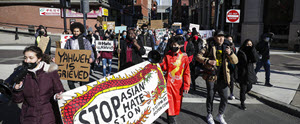Become a Patreon!
Abstract
Excerpted From: Terri Yuh-lin Chen, Hate Violence as Border Patrol: An Asian American Theory of Hate Violence, 7 Asian Law Journal 69 (December 2000) (Comment) (177 Footnotes) (Full Document)
 Violence has been an integral part of the histories and experiences of Asian Americans in the United States from our arrival in this nation to the present. Anti-Asian violence can occur at any given moment, but it is especially prevalent during periods of anti-immigrant sentiment. Most hate crimes committed against Asian Americans draw upon notions of Asian Americans as perpetual foreigners who do not belong in this society. Indeed, Victor Hwang notes how violence based on notions of foreignness has been an integral theme in Asian American history when he writes:
Violence has been an integral part of the histories and experiences of Asian Americans in the United States from our arrival in this nation to the present. Anti-Asian violence can occur at any given moment, but it is especially prevalent during periods of anti-immigrant sentiment. Most hate crimes committed against Asian Americans draw upon notions of Asian Americans as perpetual foreigners who do not belong in this society. Indeed, Victor Hwang notes how violence based on notions of foreignness has been an integral theme in Asian American history when he writes:
The Asian American community is based on an understanding and appreciation for the fact that we have struggled for nearly two centuries against this violence and exclusion in the plantations, in the courts, and on the battlefields .... It is in our struggle against this pattern of violence and its underlying message of physical, political, and historical exclusion that we find ourselves as Asian Pacific Americans.
In the United States, wherever there is foreignness, there is also a negative reaction to foreignness. This negative reaction includes setting up borders and expelling foreigners. Robert S. Chang and Keith Aoki note, “[i]n the same way that the cell wall or membrane serves a screening function, the border operates to exclude that which is dangerous, unwanted, undesirable.” The United States guards its borders seriously and marks foreigners within its physical borders according to race. Not all foreigners are treated the same by the United States. Angelo Ancheta uses the term “outsider racialization” to describe the construction of Asian Americans and other non-whites as foreigners. Outsider racialization operates on two different levels:
First, Asian Americans, Latinos, and Arab Americans are racially categorized as foreign-born outsiders, regardless of actual citizenship status. Racialization operates on multiple levels: through psychological cognition and learning, social and political discourse, and institutional structures. Second, ostensibly race-neutral categories such as “immigrant” and “foreigner” are racialized through the same social processes. Just as Asian Americans, Latinos, and Arab Americans are presumed to be foreigners and immigrants, foreigners and immigrants are presumed to be Asian, Latino, or Arab.
Thus, some immigrants are able to cross the border into the United States and gain immediate acceptance as un-foreign because of their white appearance. Racialized others may physically enter the country, but not without foreignness stamped on their faces through their racial uniforms. Accordingly, hate crimes against Asian Americans take on the unique dimension of operating as a form of border patrol and protection of the nation against the foreign “alien.” An analysis of anti-Asian hate violence must recognize the social context of foreignness in which the violence manifests as well as the reactions that foreignness triggers from the state and from private actors.
Part I of this paper briefly examines violence as a form of systemic oppression against people of color throughout history and its prevalence in particular against the Asian American community.
Part II addresses how perceptions of Asian Americans have always been and continue to be informed by stereotypes grounded in foreignness and focuses on the treatment of Asian Americans by the state.
Part III explores white American national identity in the context of immigration, white American anxiety over cultural security and over maintaining borders as a way to deal with the resulting identity crisis. This section also focuses on popular and cultural perceptions of Asian Americans as foreigners.
Part IV builds upon the notion of Asian Americans as perpetual foreigners and analyzes how perceptions of foreignness cause Asian Americans to be subject to both official state and unofficial private forms of border patrol. Hate violence is examined as constituting a form of border patrol by both state and private actors. Finally, this section considers how the construction of individual hate crimes as the sole problem ignores the border patrol function of hate violence and the role of the state in perpetuating hate violence.
[. . .]
This paper has attempted to place hate violence against Asian Americans as part of a larger context of increased border patrol. Asian Americans are marked with figurative borders, which has serious consequences, especially in the present anti-immigrant climate. Hate violence has become another way to patrol the borders of the nation which both state and private actors can participate in to preserve a white national identity and cultural security. As a community, we must turn inwards for strength rather than depend on the State to protect us. Anti-Asian violence has been a part of the Asian American community from the moment we arrived in this country and will, unfortunately, continue into the future. It is through our collective struggle against violence and exclusion that we ensure our survival.
J.D. 2000, University of California at Berkeley Boalt Hall School of Law; B.A. 1997, University of California at Berkeley.
Become a Patreon!


